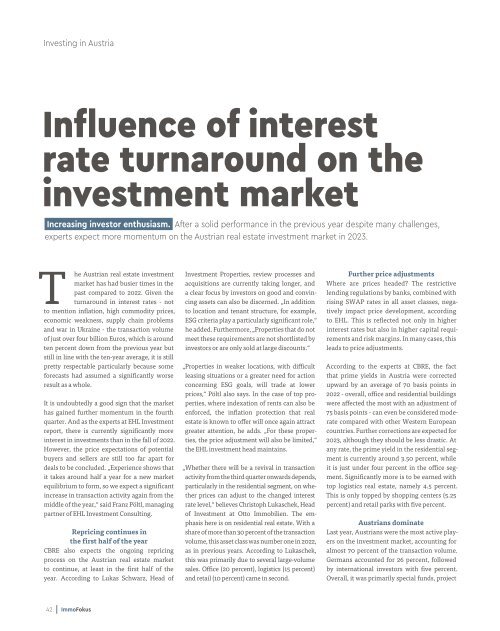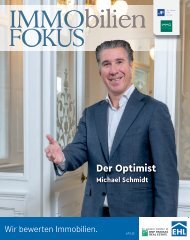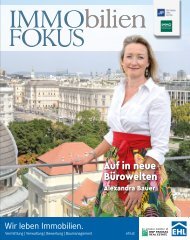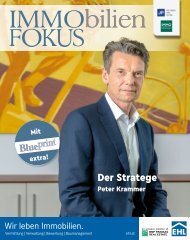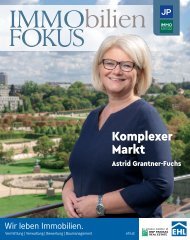MIPIM 2023 Digital Edition
You also want an ePaper? Increase the reach of your titles
YUMPU automatically turns print PDFs into web optimized ePapers that Google loves.
Investing in Austria<br />
Influence of interest<br />
rate turnaround on the<br />
investment market<br />
Increasing investor enthusiasm. After a solid performance in the previous year despite many challenges,<br />
experts expect more momentum on the Austrian real estate investment market in <strong>2023</strong>.<br />
T<br />
he Austrian real estate investment<br />
market has had busier times in the<br />
past compared to 2022. Given the<br />
turnaround in interest rates - not<br />
to mention inflation, high commodity prices,<br />
economic weakness, supply chain problems<br />
and war in Ukraine - the transaction volume<br />
of just over four billion Euros, which is around<br />
ten percent down from the previous year but<br />
still in line with the ten-year average, it is still<br />
pretty respectable particularly because some<br />
forecasts had assumed a significantly worse<br />
result as a whole.<br />
It is undoubtedly a good sign that the market<br />
has gained further momentum in the fourth<br />
quarter. And as the experts at EHL Investment<br />
report, there is currently significantly more<br />
interest in investments than in the fall of 2022.<br />
However, the price expectations of potential<br />
buyers and sellers are still too far apart for<br />
deals to be concluded. „Experience shows that<br />
it takes around half a year for a new market<br />
equilibrium to form, so we expect a significant<br />
increase in transaction activity again from the<br />
middle of the year,“ said Franz Pöltl, managing<br />
partner of EHL Investment Consulting.<br />
Repricing continues in<br />
the first half of the year<br />
CBRE also expects the ongoing repricing<br />
process on the Austrian real estate market<br />
to continue, at least in the first half of the<br />
year. According to Lukas Schwarz, Head of<br />
Investment Properties, review processes and<br />
acquisitions are currently taking longer, and<br />
a clear focus by investors on good and convincing<br />
assets can also be discerned. „In addition<br />
to location and tenant structure, for example,<br />
ESG criteria play a particularly significant role,“<br />
he added. Furthermore, „Properties that do not<br />
meet these requirements are not shortlisted by<br />
investors or are only sold at large discounts.“<br />
„Properties in weaker locations, with difficult<br />
leasing situations or a greater need for action<br />
concerning ESG goals, will trade at lower<br />
prices,“ Pöltl also says. In the case of top properties,<br />
where indexation of rents can also be<br />
enforced, the inflation protection that real<br />
estate is known to offer will once again attract<br />
greater attention, he adds. „For these properties,<br />
the price adjustment will also be limited,“<br />
the EHL investment head maintains.<br />
„Whether there will be a revival in transaction<br />
activity from the third quarter onwards depends,<br />
particularly in the residential segment, on whether<br />
prices can adjust to the changed interest<br />
rate level,“ believes Christoph Lukaschek, Head<br />
of Investment at Otto Immobilien. The emphasis<br />
here is on residential real estate. With a<br />
share of more than 30 percent of the transaction<br />
volume, this asset class was number one in 2022,<br />
as in previous years. According to Lukaschek,<br />
this was primarily due to several large-volume<br />
sales. Office (20 percent), logistics (15 percent)<br />
and retail (10 percent) came in second.<br />
Further price adjustments<br />
Where are prices headed? The restrictive<br />
lending regulations by banks, combined with<br />
rising SWAP rates in all asset classes, negatively<br />
impact price development, according<br />
to EHL. This is reflected not only in higher<br />
interest rates but also in higher capital requirements<br />
and risk margins. In many cases, this<br />
leads to price adjustments.<br />
According to the experts at CBRE, the fact<br />
that prime yields in Austria were corrected<br />
upward by an average of 70 basis points in<br />
2022 - overall, office and residential buildings<br />
were affected the most with an adjustment of<br />
75 basis points - can even be considered moderate<br />
compared with other Western European<br />
countries. Further corrections are expected for<br />
<strong>2023</strong>, although they should be less drastic. At<br />
any rate, the prime yield in the residential segment<br />
is currently around 3.50 percent, while<br />
it is just under four percent in the office segment.<br />
Significantly more is to be earned with<br />
top logistics real estate, namely 4.5 percent.<br />
This is only topped by shopping centers (5.25<br />
percent) and retail parks with five percent.<br />
Austrians dominate<br />
Last year, Austrians were the most active players<br />
on the investment market, accounting for<br />
almost 70 percent of the transaction volume.<br />
Germans accounted for 26 percent, followed<br />
by international investors with five percent.<br />
Overall, it was primarily special funds, project<br />
42 ImmoFokus


